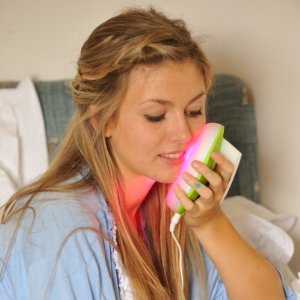 The short answer is yes, red light therapy is effective in treating most cases of acne, especially when combined with blue light therapy.
The short answer is yes, red light therapy is effective in treating most cases of acne, especially when combined with blue light therapy.
In a study published in the British Journal of Dermatology, combination red and blue light therapy produced a 76% improvement in acne pimples and inflammation after 12 weeks. Participants used light at 415 nm and 660 nm for 15 minutes each day.
Scientists have known for some time now that certain wavelengths of blue light, when concentrated enough and applied in a particular way, kills bacteria. This is the basis for blue-light bacteria killing air filtration systems. The biggest problem with using blue light to kill bacteria is that the light must be extremely bright. Usually, any bulb that produces such bright light gets hot and would burn you if you tried to put your skin near it.
The solution, then, is to use powerful light emitting diodes (LED’s). These produce very bright light without the heat, so your skin can get very close to the light source. There are many devices on the market that use blue light therapy to treat acne.
Most of these devices are expensive. A much better option is an LED light therapy/LLLT bulb which is far less costly and can be used with any regular lamp.
Photodynamic therapy is similar to low level laser/light therapy, except that it involves applying a chemical to the skin to make it more reactive to the light or laser treatment. Blue light is usually used for photodynamic therapy. The effects are about as good as those of Accutane (an anti-acne prescription medication). Photodynamic therapy treatments are believed to work by normalizing the sebaceous glands and by killing bacteria. Unfortunately, these treatments can be expensive and may not be gentle enough to use on sensitive skin, which many acne sufferers have.
Red Light Therapy and Blue Light Therapy for Acne
Red light therapy and blue light treatment are effective for most people when used correctly. It kills off the bacteria on the skin that is associated with acne, speeds up the healing of pimples and some cysts and increases the body’s ability to heal and regenerate scarred areas.
Low Level Light Therapy (LLLT) for Acne and Skin Wounds
Low level light therapy (LLLT) has many benefits for the skin. It uses non-laser light at specific wavelengths to achieve different effects.
LLLT bulbs and devices use light-emitting diodes (LEDs) to produce light that is powerful enough to be effective, without becoming too hot for the skin. For acne, blue light is typically used, often in addition to red light therapy. Blue light kills bacteria, which is why it is used in some hospital HEPA filters and in dental tools. As an added benefit, blue light kills viruses, so it makes cold sores heal much faster. For most people with acne, blue light therapy is the most useful.
Red light LLLT devices also produce benefits for acne-prone skin, but red light doesn’t kill bacteria. It increases the skin’s ability to heal itself, increasing circulation and stimulating immune response. For this reason, it is useful for healing skin wounds and relieving pain. If your acne is not entirely due to bacteria or you need wounds to heal faster, red light therapy might be more useful than blue for you.
Infrared Light Therapy for Acne
Another major category of LLLT is infrared light therapy. Near infrared light penetrates the skin deeper than red light and greatly reduces healing time. Infrared light isn’t visible, but it does produce warmth, so you can tell it’s there. If you have cystic acne, which is deeper under the skin than regular acne, near infrared light would be a good choice for you. It makes your body heal the cyst much faster, which often includes bringing it to a head so it can rupture and drain on its own before healing up. Infrared and red lights also ease any pain you may have in the area.
Near infrared light also improves or heals scars. It strengthens the collagen in the skin, leading to less sagging, fewer wrinkles and improved appearance of scars. The only downside is, ladies, it’s going to make the hair grow faster wherever it’s exposed. While that’s fantastic if you’re pointing it at your hair, it’s not so fun when you’re pointing it at your face. You may have to wax, pluck, shave, etc. more often.
All of these LLLT types- blue, red and infrared- can be used more than once per day. You could even use all three types to achieve maximum benefit if you like.
With infrared light therapy, be sure to use proper eye protection to protect your retinas. Infrared light therapy is very safe, but staring into the light repeatedly could damage your retinas, which are fragile because they’re meant to absorb light.
If you have any medical condition, it’s important to check with your doctor before using light therapy. While light therapy is very safe, it is quite powerful and some with medical conditions or those who are pregnant should err on the side of safety when it comes to using any new treatment.